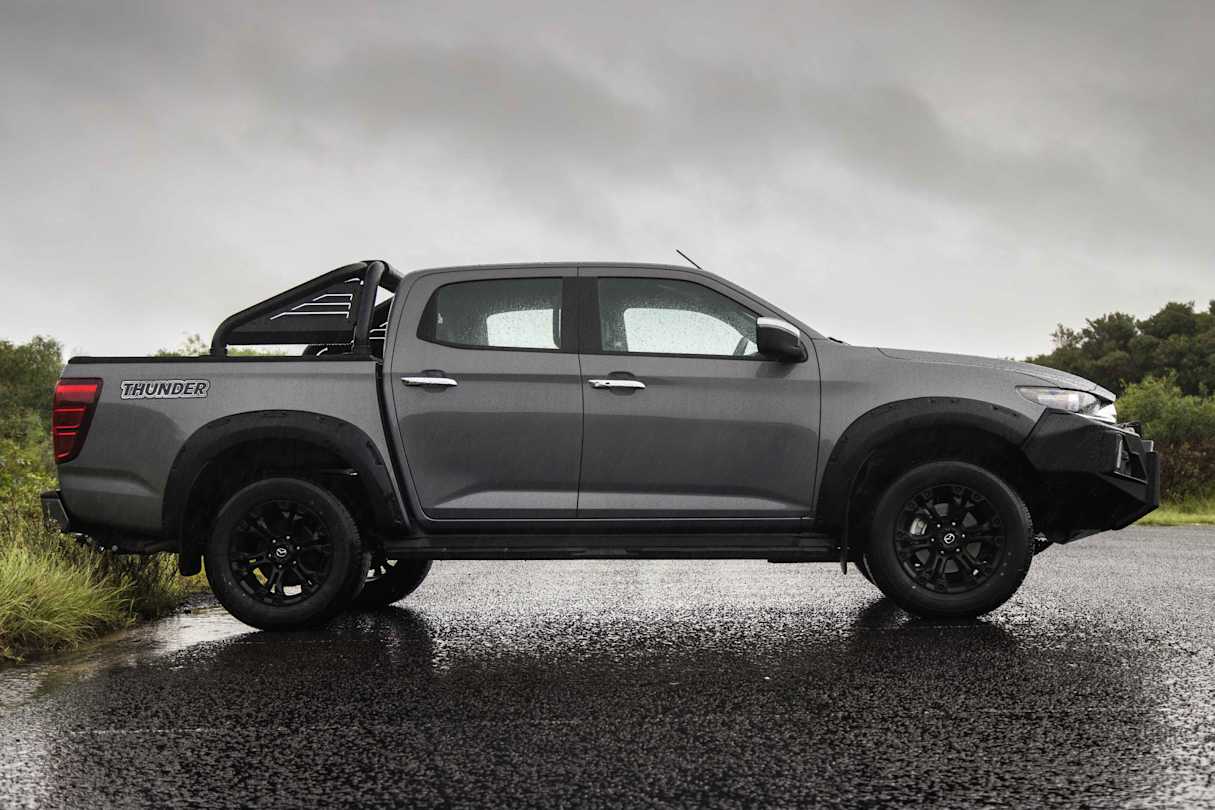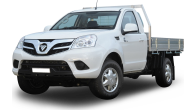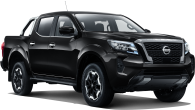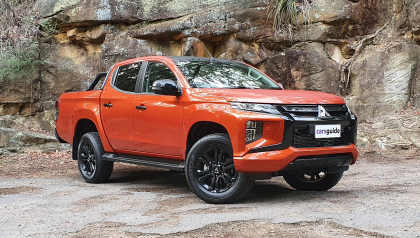The BT-50 has attracted its fans over the years, even with quite a polarising front-end look in recent years.
Well, last year Mazda ushered in a new phase for the ute with a line-up now built on a platform shared with the Isuzu D-Max* – not the Ford Ranger as it had been before – and a distinctively Mazda carry-over look. (* So, the two utes are essentially the same vehicle – engine, drivetrain and chassis – under the panels.)
The car manufacturer didn’t stop there either, because its top-of-the-range BT-50 is no longer the GT, it is now the Thunder, a new offering, kitted out with adventure-ready accessories.
But is it any good?
Read on.

Mazda BT-50 2021: Gt Thunder (4X4)
| Engine Type | Diesel Turbo 4, 3.0L |
|---|---|
| Fuel Type | Diesel |
| Fuel Efficiency | 8.0L/100km (combined) |
| Seating | 5 |
| Price From | $38,500 - $45,320 |
| Safety Rating |
|
Does it represent good value for the price? What features does it come with?
The BT-50 Thunder has a manufacturer suggested retail price (MSRP) of $65,990 (plus on-road costs) for the dual-cab 4x4 with a six-speed manual gearbox, and $68,990 (plus on-road costs) for the six-speed automatic transmission variant, our test vehicle.
The BT-50 Thunder is based on the until-now top-spec GT and, as such, its standard features include a 9.0-inch multimedia screen with sat nav, eight-speaker stereo, chrome heated exterior mirrors, heated front seats, eight-way power-adjustable driver’s seat, dual-zone climate control, auto dimming rear view mirror, 18-inch wheels, and LED daytime running lights and fog lights.

On top of that, the ‘Thunder’ designation adds a single-hoop steel bull bar, a Lightforce dual-row LED lightbar, wide fender flares and side steps, sailplane-style sports bar, an electric roller tonneau, 18-inch black alloy wheels, and ‘Thunder’ decals on the tub sides.
Mazda reckons those accessories represent more than $13,000 in total value.

All Mazda BT-50 exterior colours – Ice White, True Black Mica, Ingot Silver Metallic, Concrete Grey Mica, Gun Blue Mica, Rock Grey Mica and Red Volcano Mica – are available for the BT-50 Thunder, at no additional cost.
Our test vehicle’s exterior is concrete grey Mica, and its interior is Chroma brown leather.
Is there anything interesting about its design?
The BT-50 is 5470mm* long (with a 3125mm wheelbase), 1870mm wide, 1790mm high and this auto GT BT-50 has a listed kerb weight of 2035kg, so the accessories-laden auto GT-based Thunder will be a bit heavier than that figure. (* A standard GT is 5280mm long.)

The BT-50 now has very much an urban-friendly look – tying in with Mazda’s Kodo design language – and so it looks a lot like every new Mazda.
The Thunder treatment – including the single-hoop steel bull bar, LED lightbar, pronounced fender flares, chunky side steps, sailplane-style sports bar, 18-inch black alloys, and ‘Thunder’ decals – is low-key enough to excite BT-50 fans and not really offend anyone else, but the stickers are pretty ordinary.

What are the key stats for the engine and transmission?
It has a 3.0-litre four-cylinder turbo-diesel engine, producing 140kW at 3600rpm and 450Nm at 1600-2600rpm. Those power and torque figures actually represent a decrease of 7kW and 20Nm from the previous BT-50’s five-cylinder engine.
Our test vehicle has a six-speed automatic transmission, and a selectable four-wheel drive system (with high- and low-range 4WD), and a lockable rear diff.
The engine and auto generally make for a reasonable real-world-driving combination, but overall it feels underdone: the engine could do with more grunt and the transmission is just not quite as smooth as it should be.

How practical is the space inside?
There's plenty of nice soft-touch Chroma brown leather, with chrome-look here and there, and there are also expanses of hard plastic.
All in-cabin controls are easy to locate and operate.
The multimedia screen is a decent size and easy enough to use, although I didn't find it as easy to operate as the Navara's, for instance, which I'd just been in. It does have Apple CarPlay (USB and wireless) and Android Auto (USB only). We have noted before that, because of the new BT-50's screen size and the way it's positioned, it catches glare during the day, especially on bright sunny days, which can be annoying. During our BT-50 Thunder test days though, during NSW's recent heavy rains and floods, we obviously didn't have that problem.

The front seats are comfortable, and heated. The driver’s seat is eighty-way power-adjustable.
There are plenty of storage spaces around the cabin, including cup holders in the centre console, bottle holders in the doors, as well as all of the usual receptacles for your every day carry gear.

There’s a 12-volt socket and a USB port upfront.
Both seat-backs have a map pocket and there is a fold-out shopping-bag hook on the back of the front passenger seat.
The rear seats are not heated but comfortable, with room enough for three adults.
Back-seat passengers get cupholders in the fold-down arm-rest, directional air events, and a USB socket in the back of the centre console.

The back row will accommodate two child seats, as it has one ISOFIX anchor point on each outer seat and a central top-tether point.
There is shallow storage under the rear seats.
Some minor build-quality issues, that I noted in a review of the GT, persist in the cabin – hard plastic panels that aren’t quite flush, and a glove box that ‘sticks’ when you're trying to open it – but these are not deal-breakers if you're already keen on a BT-50.
Overall, it is a nicely laid-out and comfortable cabin, but it feels a little less premium than it should.
What's it like as a daily driver?
The Thunder is essentially an auto GT with accessories on; nothing separates it mechanically or otherwise from a standard GT, so my previous drive impression of the GT remains somewhat unchanged: the new BT-50 is a pleasant daily driver, but it’s never as refined as something like the Ford Ranger, for example.
However, spending time again in a BT-50 GT variant has revealed a few things to me.
Steering remains quite well-weighted and accurate, and it suits this ute.

The engine and auto, as mentioned, are generally a pretty decent pairing but the engine does lack real punch, and the auto can become a bit busy, but is clever most of the time. This combination seems a better fit in the BT-50’s platform-mate, the D-Max, than it does here.
There’s enough power and torque on tap – even though there has been a decrease – but it doesn't impact general driving duties much.
In terms of noise level, it’s rather well subdued, although there is more than a touch of diesel clutter in general driving, and especially when you accelerate hard.

Suspension – independent double wishbone with coil springs and anti-roll bar at the front, and a rigid (live) rear axle with leaf springs at the rear – is generally nicely composed, albeit a bit firm.
Overall, I found the BT-50's ride quality to be a touch patchier, engine noise more noticeable, and the auto a tad fussier than in something like the new Navara ST-X I’d just tested before driving the Thunder. The Mazda actually feels like it has to work a touch harder than its twin-under-the-metal D-Max (which we have on a long-term loan in X-Terrain guise) or even the Navara, during day-to-day driving.
What's it like for touring?
Our test vehicle has a six-speed automatic transmission, and a selectable four-wheel drive system (with 2H, 4H and 4L), and a lockable rear diff.
In terms of off-road measurements and angles, the BT-50 has 240mm of ground clearance, a wading depth of 800mm and approach, departure and ramp-over angles of 25.8 degrees*, 24.2 degrees and 23.8 degrees, respectively. (* A GT has a 30.4-degree approach angle because it doesn’t have the Thunder’s bull bar. In terms of off-road angles, the higher the number, the better.)
I’ve already driven GT variants many times over 4WD-only terrain – including corrugated and potholed dirt tracks, rocky inclines, and steep, severely-rutted hill-climbs – and they’ve always performed rather well on the terrain and in the conditions.

The recent NSW floods forced a change in our test-route and this time wasn’t as big a challenge for the BT-50 because I took it on a stretch of very wet and hard-packed coastal sand and the Mazda ute didn’t disappoint.
With tyre pressures dropped to 20 psi (pounds per square inch) and 4H (4WD high-range) selected, the Thunder tackled the firm sand with no strife.
No need for a heavy right boot, just controlled, sustained momentum, via good gearing, an unstressed engine and a quietly effective traction control system.
I only ever had to use 4L (4WD low-range) – and lower tyre pressures – on a nearby steep dirt-track hill and, suffice to say, low-range gearing is good, without necessarily turning the BT-50 into a hard-core rock-crawling beast.
The suspension is generally firm, even a little stiff, through harsher imperfections in track or road surfaces.

The Thunder rides on Bridgestone Dueler H/T 684II (265/60R18), which are fine for general driving duties with some light-duty off-roading thrown into the mix, but if you’re planning on doing a lot of off-road touring, think about replacing this rubber with a set of more-aggressive all-terrain tyres.
The tub has two tie-down points, a sturdy-looking tub liner, and an electric tonneau cover that’s easily operated via an open-close button on top of the tub’s rear right-hand rail.

If you want to add even more gear to your Thunder, there are numerous BT-50 accessories available, with everything from seat covers and rubber floor mats, to ladder racks and suspension upgrades.
The BT-50’s tub is 1571mm long, 1530mm wide (at top-edge height), 1120mm wide between the wheel arches, and 490mm deep. Load height is listed as 833mm (from the ground).
The Thunder's payload is 887kg (auto) and 897kg (manual), and towing capacities are listed as 750kg (unbraked) and 3500kg (braked).
The GT’s GVM (gross vehicle mass) is a claimed 3100kg; and gross combined mass (GCM) is 5950kg.

How much fuel does it consume?
Fuel consumption is a listed as 8.0L/100km on a combined cycle for the auto.
The dash display was showing 7.5L/100km. I recorded an actual fuel consumption of 10.8L/100km, and that was after more than 200km of on- and off-road driving, including high- and low-range 4WDing.
The BT 50 has a 76-litre fuel tank.

Warranty & Safety Rating
What safety equipment is fitted? What safety rating?
The Mazda BT-50 has a maximum five-star ANCAP crash test rating, from testing in October 2020.
Safety gear includes eight airbags (dual front, driver’s knee, front centre, front side, full-length curtain), AEB, front parking sensors, reverse camera, blind spot monitor, attention assist, lane keep assist, emergency lane keeping, lane departure prevention and warning, rear cross traffic alert, and more.

It also has traction control, hill descent control and hill launch assist.
All 4WD BT-50s have a rear diff lock.
What does it cost to own? What warranty is offered?
A five-year/unlimited kilometre warranty applies to the new BT-50 range.
Roadside assist is valid for five years.

Servicing is set at 12-month/15,000km intervals, whichever comes first, and capped price servicing applies for seven years/105,000km.
Annual service cost over seven years averages out to $496.
Verdict
Putting aside the Thunder designation for a moment, the BT-50 in GT spec is a pretty decent ute as standard and with its tractable engine, comfortable cabin and ample driver-assist tech, it makes for a nice daily-driving experience and it is capable off-road.
Sure, it has less power and torque than it did before, and it’s not as refined as something like a Ford Ranger or VW Amarok, but it is a ute that’s easy to live with day to day.
If someone is already keen for a BT-50, then the Thunder treatment – with its raft of adventure-ready additions – will simply add to its appeal.
Pricing Guides

Range and Specs
| Vehicle | Specs | Price* |
|---|---|---|
| Gt (4X4) | 3.0L, Diesel, 6 SPEED AUTOMATIC | $39,050 - $45,980 |
| Xs (4X2) | 1.9L, Diesel, 6 SPEED AUTOMATIC | $31,020 - $37,400 |
| Xs (4X4) | 1.9L, Diesel, 6 SPEED AUTOMATIC | $33,000 - $39,270 |










.jpg)
.jpg)
.jpg)










.jpg)
